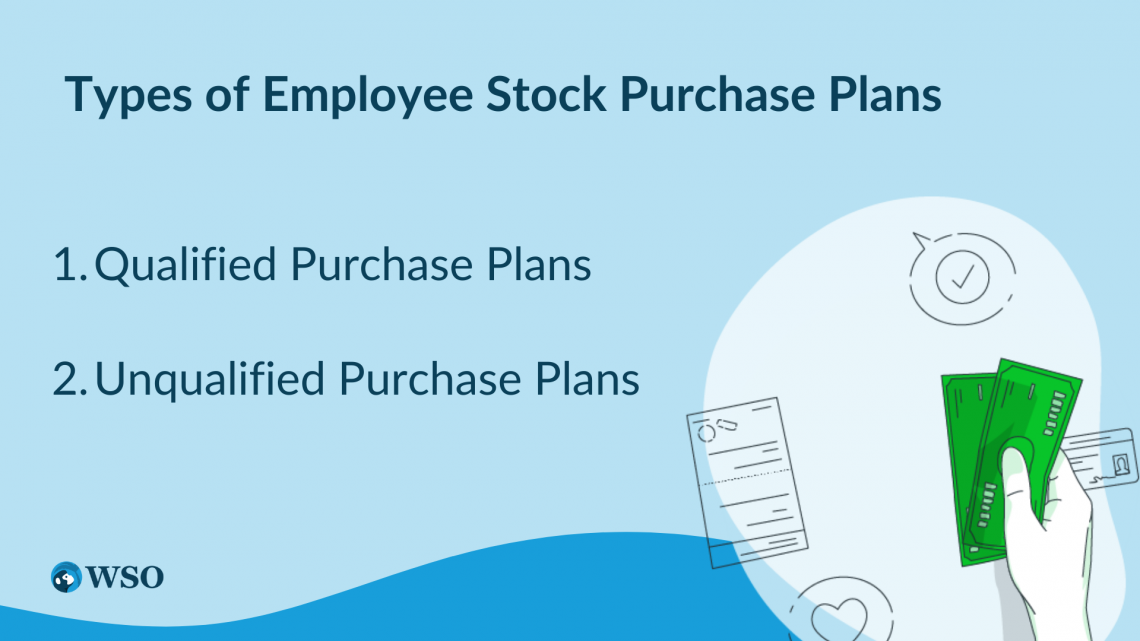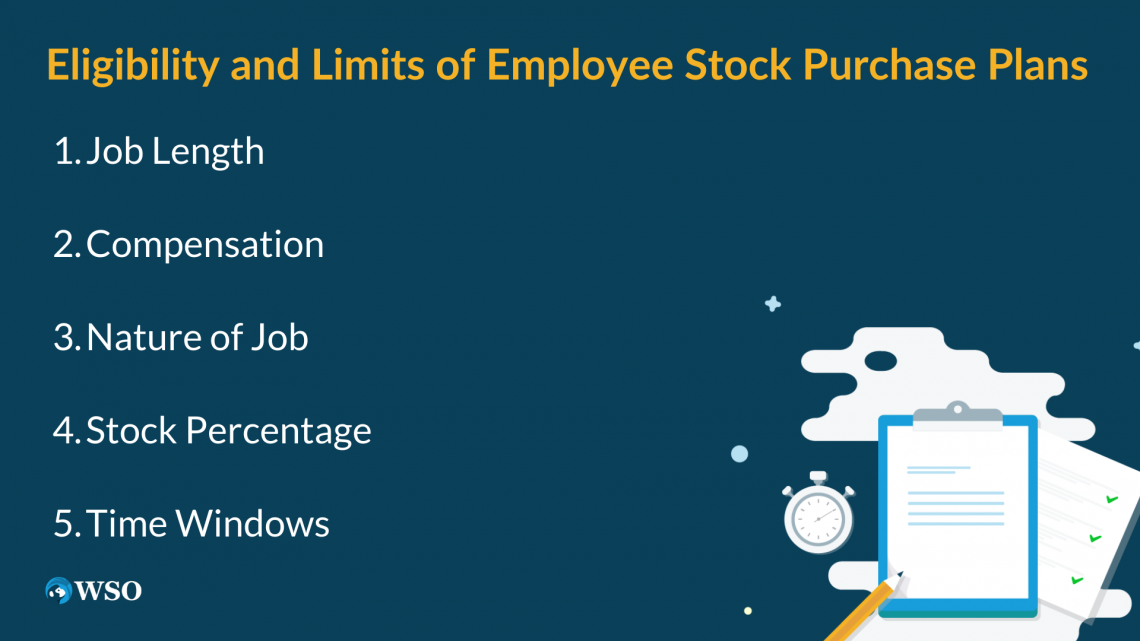Employee Stock Purchase Plan (ESPP)
It is a system that allows employees to purchase discounted stock of the company.
What Is an Employee Stock Purchase Plan (ESPP)?
An employee stock purchase plan, also known as an ESPP, is a company program. This program allows participating employees to buy company stock at a discount.

Employees participating in these plans take a deduction on their payroll to finance these discounts. As this amount builds up, more stock will be available to be purchased at a discount price between the offering date and the purchase date.
During a purchase date, the company will use all deducted funds to purchase any stocks in the company on behalf of the participants. This system allows them to support their own company and purchase stocks to benefit themselves and the company.
The price of stock under this program will be around 85% to 90% of market value. This original price can be the current market value, or it can use a historical closing price of the stock. Usually, the program will fluctuate between these two depending on which is the lower of the two.

While this does seem like a fantastic program for employees to benefit themselves and invest in a company they believe in, most ESPPs require that a participant not own more than 5% of the company and be employed for at least one year.
It's important to note the taxes on these programs. Generally, any dispositions are taxed on the year of the sale of the stock.
Key Takeaways
- ESPP (employee stock purchase plan) is a system that allows employees to purchase discounted stock of the company they work for.
- A discounted stock is usually purchased at around 85-90% of market value.
- The plan is funded from deductions in an employee’s paycheck.
- Employees are allowed to not participate in the ESPP and deductions.
- The program is generally available to any full-time working employee for +2 years.
- Different companies will have different plans, while some have no plans.
- All ESPP, follow laws set by the government that regulate eligibility.
Types of Employee Stock Purchase Plans
Within the realm of ESPPs, there are two main programs that companies can operate with.
These include qualified and non-qualified plans.

Although these plans do operate in a similar fashion, allowing employees to purchase a stock of a company or work with, they each have their own distinct differences and benefits.
1. Qualified
Often enough, qualified ESPPs are one of the more restrictive types of employee stock-purchasing plans. Plans often require shareholder approval before starting. Additionally, the period of time for a qualified ESPP cannot exceed 3 years.
And on top of all of that, there are even sometimes restrictions on the maximum discount available on the stocks. Although there are multiple restrictions on this type of stock plan, these plans often give all participants equal rights.
All these restrictions come directly from the IRS, as these plans must adhere to their criteria. Specifically directly from the IRS, offering periods cannot exceed 27 months, and the discount price may not exceed 15%.

These restrictions do place a heavy burden upon the plan and limit its ability to benefit employees. Since this planet hears the criteria of the IRS, often enough tax burdens are much less compared to other forms of EPPs.
2. Unqualified
Similar to qualified plans, unqualified ESPPs also give employees the opportunity to invest in their own Financial life and the company's well-being. These plans are much simpler and do not adhere to the rules and regulations of qualified plans.
They follow fewer restrictions and are more open than qualified plans. This allows an employee to benefit the most from purchasing stocks of a company since there are no limits to the amount of the discount or the period in which they can buy a stock.
Unfortunately, because these types of plans do not adhere to IRS standards, they more or less are taxed at a higher rate compared to qualified plans. Most taxes under this plan will be subjugated to income tax rather than long-term capital gain from stocks.

Either of these plans is a great option for employees to begin investing in their company and their future. Each company will decide to use a different plan for different reasons, and it's important for you to understand your company's policies and decisions.
Knowing the differences between qualified and unqualified EPPS is crucial to maximizing the benefit you can get from these plans.
Some companies will have fewer restrictions on their plans and allow for you or another employee to purchase more stocks compared to a qualified plan.
On the other hand, qualified plans are often much more structured and rigid compared to unqualified plans. These plans are more restrictive but they do allow employees to invest in stocks without having to worry about additional tax burdens.
Note
Some companies will set up ESPPs through another party. Companies like Fidelity will work with companies to set up these systems.
Eligibility and Limits of Employee Stock Purchase Plans
Although employee stock purchasing plans seem like a great way for all employees to benefit from a company's growth, not all employees are allowed to participate in this program.

Some of these limitations include regulations on the amount of stock an employee can purchase, the aggregate value of all stocks purchased, the time window in which an employee can purchase stock.
The following are some of the most common exclusions in ESPP plans:
1. Job Length
Almost all employee stock purchasing plans will have a requirement on employment for employees to participate in this plan. It's required that employees work for 2 years before taking part.
This helps to minimize employees solely looking for a company with a good plan. These invasive tactics are often used by people looking to buy Blue Chip stocks at a discount rather than at market price.
2. Compensation
In most instances, the top earners in a company are not allowed to participate in this plan. An ESPP Is often reserved for lower earners within the company. This can help promote the financial security of an employee and company loyalty.
It would also be the reason that if a top earner were able to purchase stocks at a lower price, they could use their advantage in salary to purchase more stock within the company compared to a regular employee.
3. Nature of Job
A participant must be working full-time within the company. This equates to 20 hours per week for 5 months in a year.
It helps to stop fraud within the company, if an employee could simply work part-time and gain the benefits of this plan, it would undermine the work of regular employees who put in more hours and more effort into the job that they have.
4. Stock Percentage
Another requirement for ESPPs is that an employee must not own more than 5% of a company. Some companies do change this percentage to be higher or lower, but generally, 5% is the ballpark most companies restrict their employees to.
It prevents an employee from abusing this plan. When buying stock, it would give an employee an unfair advantage over the average investor.
Note
If an employee were able to purchase more than 5% of a company, they could quickly buy a large piece of a company at a fraction of the cost.
5. Time Windows
There are a lot of periods within this plan. More often than not, a discount for these stocks is only available for a short window within the year. Additionally, there are periods where a stock bought cannot be sold until a certain time has passed.
This prevents employees from buying stocks when they are extremely low. It would also stop insider knowledge from being useful.

If an employee knew a large plan was going to happen within the company, they could use this plan unfairly to buy stock at a lower discount and sell when the stock rises.
There also must be a period between buying a stock and selling it. If an employee could buy a stock at a discount, they could just as easily sell it at market price to make a quick 10 or 15% return on investment.
This is an extremely unfair system. This is why these periods are implemented within these plans to give employees a fair chance compared to the average investor.
Although these policies are some of the most common, each plan is different for each company. It's important you talk with any supervisor or personnel that is in charge of this plan and discuss all the limitations that accompany your company's plan.
It's common for companies to draft their own policies regarding these plans. Even though all ESPP plans must follow certain guidelines dictated by the government, there is variation throughout each company.

For example, the HSN Inc. policy defines multiple variables and eligibility requirements.
Any change in these plans is an important piece of information to know. When investing in a company's future, it's important that everything is known about the company and the format in which you are purchasing stock. A small change can make a large difference.
Every employee should look over and review their own company’s plan. Read all eligibility requirements and paycheck deductions. Below you can find Uber’s ESPP plan. Review it and compare it to your own company’s ESPP.
Summary
In summary, employee stock purchasing plans, or ESPPs, are an excellent program that most companies should adopt. These systems allow employees to benefit from working under a company and support the company they're working with.

By allowing employees to buy a company stock at a discount, it encourages employees to buy stock of a company in turn supporting their company. Additionally, the discount and advantages of this plan promote employee loyalty.
Although there are multiple eligibility requirements and limitations on these plans, the benefits far outweigh the costs. Most employees are eligible except for the top earners, part-time employees, and short-term employees.
Regardless of the size and profitability of your company, the ESPP gives employees the ability to buy-in on the company’s future in the financial market. If you're eligible, it's recommended that you take part in an ESPP
If your company offering ESPP is a blue-chip company with great financials, you have a unique advantage over millions of large-cap stock investors who have to pay full price for shares of stock.
Overall an ESPP is an amazing opportunity for most employees. Not only does it benefit the employer’s company, but it also immensely helps employees with their personal finances and investments.




or Want to Sign up with your social account?